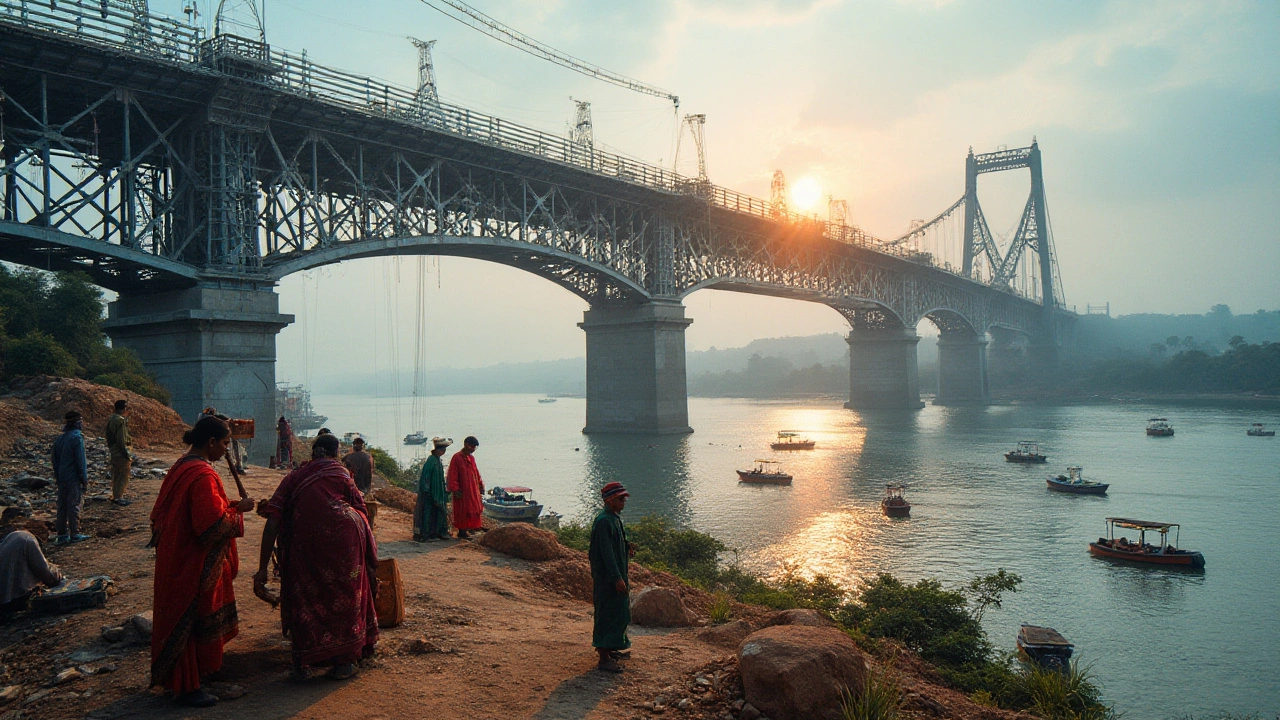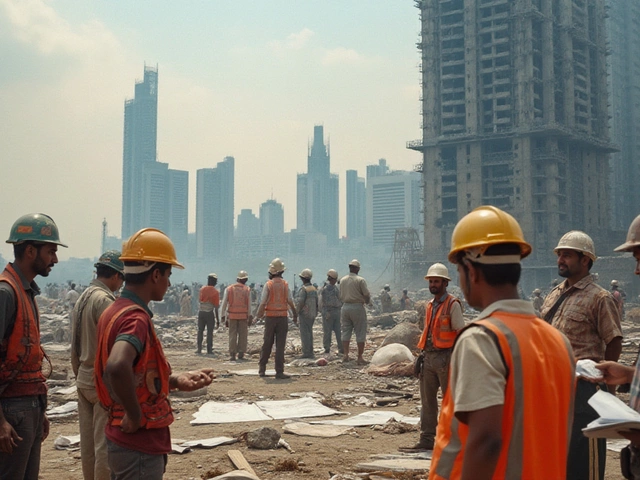When you think of construction, images of towering skyscrapers or stylish homes might come to mind. But heavy civil construction, a crucial yet often less spotlighted part of the industry, plays a vital role in our daily lives. This type of construction involves large-scale projects like highways, airports, water dams, and bridges—essential structures that keep society moving.
Heavy civil construction projects demand specialized skills and massive machinery, from bulldozers to cranes, designed to handle their sheer scale and complexity. These projects often go unnoticed by the everyday passerby, yet they underpin essential infrastructure and community development worldwide. Engaging with this sector offers deep insights into how human ingenuity shapes functional engineered landscapes amid urban sprawl.
- Definition and Scope
- Key Projects and Examples
- Skills and Equipment Needed
- Challenges and Considerations
Definition and Scope
When we delve into the world of heavy civil construction, we enter a realm where infrastructure becomes the main focus. This sector is distinct from standard commercial or residential construction, featuring projects that often span vast land areas and govern significant swathes of urban and rural landscapes. Heavy civil construction encompasses the building of transportation routes, such as highways and railways, massive structures like dams and bridges, and essential systems including water treatment facilities. These projects provide the required backbone for the functioning of a society, handling the flow of human and economic activities with seamless efficiency. The magnitude and complexity inherent in these enterprises require a blend of meticulous planning and robust execution strategies, aiming to deliver long-lasting and resilient infrastructural solutions.
The scope of heavy civil construction is inherently broad and crucially impactful. It touches on multiple aspects of societal development, ranging from laying down the foundations for advanced communication networks to safeguarding water supply through sophisticated channel systems. Noteworthy, too, is its embrace of technological advancements. Emerging tools such as Building Information Modeling (BIM) and AI-enhanced machinery are beginning to change how projects are conceptualized and carried out, facilitating improved project delivery timelines and budget management. In this arena, success hinges on collaborative efforts among engineers, architects, and government bodies, each playing an indispensable role in crafting infrastructure that defines the modern world. As noted by the American Society of Civil Engineers, "Infrastructure is the essence of a functioning civilization, reflecting our standard of living and our economic prosperity."
This field’s mandate is not just construction but also conscious design that factors in environmental concerns and future growth. Urban planners and construction managers alike stress the need to harmonize development with nature. Initiatives such as green building technologies and sustainable resource management are steadily gaining traction, seeking to mitigate the ecological footprint of construction activities. Furthermore, regulatory compliance plays a pivotal role, as heavy civil construction projects are often subject to stringent environmental and safety standards. Such regulations ensure that these vast undertakings not only meet immediate demands but also contribute positively to the ecological and social future.

Key Projects and Examples
Diving into the realm of heavy civil construction unveils a fascinating array of landmark projects shaping the very infrastructure of society. Consider the vast network of highways in the United States, such as the celebrated Interstate Highway System. Initiated in the 1950s, this ambitious project revolutionized ground transport by providing a robust and continuous network linking the entire nation, facilitating commercial transport and fueling economic growth. It's intriguing to witness how such a colossal venture not only transformed logistics but also influenced migration, suburban expansion, and even popular culture with the rise of the quintessential road trip.
Another marvel of heavy civil construction is the Three Gorges Dam in China, the world's largest power station in terms of installed capacity. Completed in 2012, this gigantic hydroelectric structure demonstrates not just engineering prowess but also showcases China's commitment to harnessing renewable energy. The dam stretches approximately 2,335 meters in length and towers about 185 meters high, its reservoir altering the course of the Yangtze River. This project reflects a grand vision—providing significant flood control, boosting shipping capacity, and generating a staggering amount of electricity, enough to cover extensive urban areas. Yet, it also highlights the complex interplay between human ambition and environmental stewardship.
The American Society of Civil Engineers calls heavy civil projects "the cornerstone of modern society, supporting economic growth and improving quality of life."
In Europe, the Channel Tunnel, or "Chunnel," stands as a towering example of international collaboration and cutting-edge engineering that dates back to 1994. Connecting the United Kingdom with mainland Europe via an underwater rail tunnel, it spans about 50 kilometers beneath the English Channel. The commercial construction challenge of creating a link under large bodies of water pushed the boundaries of tunneling technology. The initiative not only enhanced tourism and trade between the nations but also symbolized unity and progress amidst historic divides. Building such an astonishing feat required innovative techniques and meticulous planning, setting a precedent still consulted in engineering curricula today.
The Auckland Waterview Connection project, finished in 2017, showcases New Zealand's growing prowess in navigating complex infrastructural undertakings. This motorway serves as a crucial urban artery, alleviating congestion and slashing commute times in Auckland. Featuring an extensive road tunnel system and accompanying infrastructure, this project underscores the city's commitment to future-proofing its transport network. It stands as a testament to how targeted investments in infrastructure can enhance living standards by reducing travel strain, boosting economic activity, and nurturing sustainable urban development, echoing the practices seen in global heavy civil endeavors.
Each example highlights remarkable feats in engineering and project management, reinforcing the importance and impact of heavy civil construction across the globe. Such projects are not mere exercises in technical challenges; they are keystones that facilitate human progress, economic growth, and sustainable development. As societies evolve, the lessons and legacies left by these monumental works provide invaluable blueprints for future initiatives in the expanding world of infrastructure.

Skills and Equipment Needed
Engaging in heavy civil construction demands a distinctive set of skills that go beyond the typical construction job. A robust understanding of civil engineering principles is essential, as is the ability to interpret complex blueprints and maps. The projects are often built from the ground up in environments that can be unpredictable, necessitating a precise blend of academic knowledge and practical experience. Workers need to be adept in the use of software applications that facilitate project design and management. Furthermore, leadership skills are paramount because these projects incorporate huge teams working under tight deadlines. As a part of skill enhancement, understanding environmental regulations and safety standards is critical, as is being aware of the latest technological advances that can make the construction process more efficient.
The equipment involved in heavy civil construction is as impressive as the projects themselves. This sector utilizes an array of specialized machinery, each designed to handle different aspects of the construction process. Excavators and bulldozers are common sights, used to move vast quantities of earth quickly and efficiently. Pavers and rollers are crucial for roadwork, ensuring a smooth and durable surface. Cranes of various types and sizes bring to life the vertically extensive components of these infrastructure marvels. The ability to operate such machinery requires rigorous training and certification. The machinery's maintenance is equally important; routine checks and skilled mechanics ensure that equipment is safe and operational, preventing costly downtime.
According to a report by the Associated General Contractors of America, the incorporation of technology is transforming the construction industry at an unprecedented pace.
"The future of construction isn’t just building; it’s about building smarter," asserts Stephen Sandherr, CEO of AGC.Employing technologies like GPS and laser-guided machinery not only improves precision but also enhances safety by reducing the need for physical presence in potentially hazardous zones. Moreover, heavy civil projects often push forward using automated and semi-automated equipment, which minimizes human error and increases productivity. Substantial initial investments in such technology become worthwhile as they lead to significant savings and efficiency gains over time. The symbiotic relationship between skilled personnel and advanced machinery ensures these monumental projects are executed with precision and within stipulated timeframes.
Equipment Function Excavator Used for digging and moving large amounts of ground material. Bulldozer Essential for shifting soil and debris to clear and grade land. Paver Lays asphalt on roads, bridges, parking lots, and other such places. Cranes Used for lifting and moving heavy objects, crucial for tall structures. 
Challenges and Considerations
Heavy civil construction is not just about giant machines and massive blueprints; it’s a domain rife with its own set of unique challenges and critical considerations. One of the most daunting challenges lies in the environmental impacts these projects may have. The excavation, land modification, and sheer scale of operations can disrupt local ecosystems significantly. It requires a delicate balance between progress and preservation. Regulations demand rigorous environmental assessments and continuous monitoring to mitigate pollution and habitat destruction. These projects often face public scrutiny, necessitating transparent communication and proactive community engagement strategies to alleviate societal concerns and enhance local acceptance.
Costs and funding pose another significant hurdle. Because heavy civil construction projects, like highways and bridges, require substantial financial investments, securing funds can be challenging. Projects often rely on government funding, which can be subject to political shifts and budget restraints. Cost overruns are a common issue, driven by unforeseen geological conditions, fluctuating material prices, and changes in design scopes. Scheduling delays compound financial stress, often extending completion timelines and inflating expenses. Navigating these financial waters requires both sharp forecasting and flexible financial planning to adapt to these economic realities.
Managing logistics in heavy civil construction is akin to conducting a massive orchestra. The orchestration involves coordinating various contractors, ensuring the supply of materials, and scheduling the workforce across extensive sites. Geographical challenges like rugged terrain or remote locations can complicate logistics, leading to delays and increased costs. Safety is another paramount concern, with large-scale projects posing higher risks of accidents due to the extensive use of machinery and hazardous materials. Strict adherence to health and safety regulations mitigates these risks, emphasizing the importance of safety training and vigilant onsite monitoring. As noted by
New Zealand's Ministry of Business, Innovation, and Employment, 'Safety in the construction industry is evolving, but the responsibility lies with everyone involved in the project.'Another hurdle is technological adaptation, as the industry advances with innovations like smart sensors, drones for site surveys, and Building Information Modeling (BIM) for project visualization. These tools offer vast improvements in efficiency and accuracy, yet their integration requires investment in technology and training the workforce. Complex projects often entail interdisciplinary coordination and can benefit from digital platforms that facilitate real-time collaboration and data sharing. However, smaller firms might find it challenging to keep up with the swift pace of technological advancements, weighing the benefits against the significant initial costs and ongoing maintenance of implementing these new systems.
When considering labor, heavy civil construction relies heavily on skilled workers capable of operating complex machinery and executing detailed plans. Facing a skilled labor shortage remains a pressing issue. This shortage impacts project timelines and quality, and emphasizes the need for industry-specific education and apprenticeships to prepare the next generation of workers. Efficient workforce management involves not just lining up labor with project demands, but also addressing worker welfare issues, ensuring adequate rest, resilience resources, and understanding the cultural dynamics of a globally diversified team for smoother interpersonal operations.



Write a comment